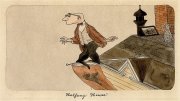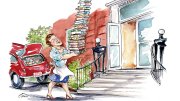An art forger’s success has less to do with “his prowess as a visual artist than with his use and misuse of history.” So writes Jonathan Lopez ’91 in “A Liar’s Biography,” the introduction to his new work, The Man Who Made Vermeers: Unvarnishing the Legend of Master Forger Han van Meegeren (Harcourt, $26). More from the astonishing tale:
At the end of World War II, shortly after the liberation of Amsterdam, the Dutch government threw wealthy artist Han van Meegeren into jail as a Nazi collaborator, charging that he had sold a priceless Vermeer to Hermann Goering during the German occupation. In a spectacular turn of events, Van Meegeren soon broke down and confessed that he himself had painted Goering’s Vermeer. The great masterpiece was a phony.
While he was at it, Van Meegeren also admitted to forging several other pictures, including Vermeer’s famed Supper at Emmaus, the pride of Rotterdam’s Boijmans Museum, a painting once hailed by the prominent art historian Abraham Bredius not merely as a masterpiece, but indeed “the masterpiece of Johannes Vermeer of Delft.” When the news got out, it made headlines around the world, and the forger became an instant folk hero. In widely reported interviews at the time, Van Meegeren claimed to be a misunderstood genius who had turned to forgery only late in life, seeking revenge on the critics who had scorned him early in his artistic career.
An ancient grievance redeemed; a wrong put right. It was a wildly appealing tale back in 1945, and indeed it remains quite seductive today. In the Netherlands…the story of the wily Dutchman who swindled Hermann Goering continues to raise a smile.
But the forger had one more trick up his sleeve: his version of events turns out to have been extravagantly untrue.
…Van Meegeren worked for decades with a ring of shady art dealers promoting fake old masters, some of which ended up in the possession of such prominent collectors as Andrew Mellon and Baron Heinrich Thyssen. All the while, Van Meegeren cultivated a fascination with Hitler and Nazism that, when the occupation came, would provide him entrée to the highest level of Dutch collaborators.
Art fraud, like other fields of artistic endeavor, has its own traditions, masters, and lineages. When Van Meegeren entered the world of forgery, he joined a preexisting culture of illicit commerce that had thrived in Europe and America for years and would continue to thrive throughout the first half of the twentieth century, a time when the market for old masters was booming….The picture swindles with which Van Meegeren was involved during the 1920s were remarkable both for their financial scale and for the numbers and types of people involved.…[H]e knew precisely how to seize on the zeitgeist and turn it to his own ends; to match what people wanted to hear with what he wanted them to believe.








